If you’re trying to get a new project off the ground, you need approval and buy-in from the right people.
This is where a project charter comes into the picture.
With a project charter, you outline all your project information in a single document for them to review. It gets everyone on the same page and helps key stakeholders make an informed decision about whether the project should proceed.
But how exactly do you write a project charter?
If you’ve been asking yourself this question, you’ve come to the right place for answers. In this article, we’ll walk you through writing a project charter and answer some of the most frequently asked questions about project charters so you can get started on the right foot.
What is a project charter in a project?
A project charter is a formal document that outlines a project’s purpose, objectives, scope, and key deliverables. It’s used to gain approval for a project, determine its direction, and set boundaries for the project work.
It also provides stakeholders with a shared understanding of the project’s purpose and, and keeping everyone aligned on its direction.
The charter is typically developed during the initiation phase of a project, which is the first step in starting a new project. The charter then serves as a reference point throughout the project’s lifecycle, ensuring everyone is working towards the same goal.
Why is a project charter important?
Here are some reasons a project charter is important in project management.
- Establishes project authority. The project charter establishes the authority and legitimacy of the project team. How? By clarifying the project manager’s role and responsibilities. In doing so, it provides them with the necessary authority to lead the project and make decisions.
- Sets project boundaries and scope. A project charter defines the project's boundaries and scope, outlining what’s included and excluded from the project. This provides stakeholders with a clear understanding of what the project will deliver, minimizing scope creep and preventing misunderstandings later in the project.
- Provides a basis for decision-making. The project charter is a reference point for decision-making throughout the project. How? Because it provides a clear vision and direction. It guides the project team's decisions and makes sure they’re aligned with the project's objectives.
What are the key elements of a charter?
Multiple elements form a project charter:
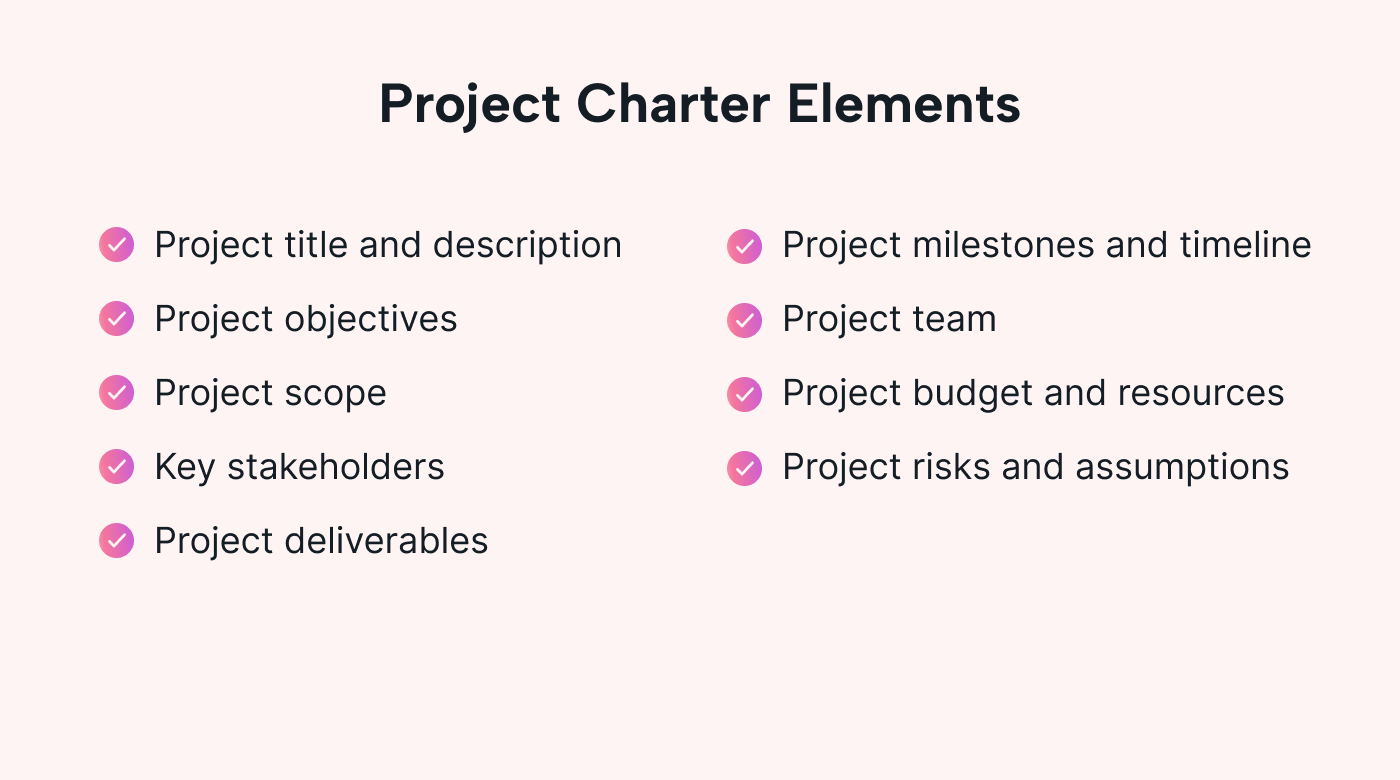 |
Let’s define these in more detail.
- Project title and description. A brief overview of the project, outlining its purpose, objectives, and desired outcomes. It should provide context for stakeholders to understand the importance and relevance of the project.
- Project objectives. Clear and concise statements that define what the project aims to achieve. These objectives should also outline the specific, measurable actions you’ll take to bring you closer to your long-term goals.
- Project scope. A description of the project’s boundaries and the extent of the work. It defines what’s included and excluded from the project, helping stakeholders understand its focus. It also allows project managers to plan work and allocate resources accordingly.
- Key stakeholders. An overview of the individuals or groups interested in the project’s success. This includes project sponsors (usually high-level management), team members, clients, users, and anyone else affected by the project..
- Project deliverables. These are the tangible outputs that the project should produce. For example, a new product or feature. This helps stakeholders understand the project's outcome and how to determine whether it’s been successful.
- Project milestones and timeline. A high-level overview of major events or milestones in the project’s lifecycle and an estimated project timeline.
- Project team. A list of project team members, their roles, the reporting structure, and the project manager's authority.
- Project budget and resources. An overview of the budget and resources required for the project, including team capacity, equipment, and materials. This helps stakeholders understand what the project involves and how to allocate resources effectively.
- Project risks. Any potential risks that could crop up during the project, how to prevent them, and what to do if they occur.
How to create a project charter
Now that we know what a project charter document is and what it includes, let’s walk through the steps you can follow to create a project charter of your own.
1. Outline the project information
This first section of your project charter includes your project’s general information. This includes the project name, the project sponsor, the project manager, their contact information, and the project's estimated start/end date.
Essentially, it should provide all the top-level information about your project in a single glance.
Consider putting it into a table to make it easier for people to digest this information. Here’s an example of how that might look:
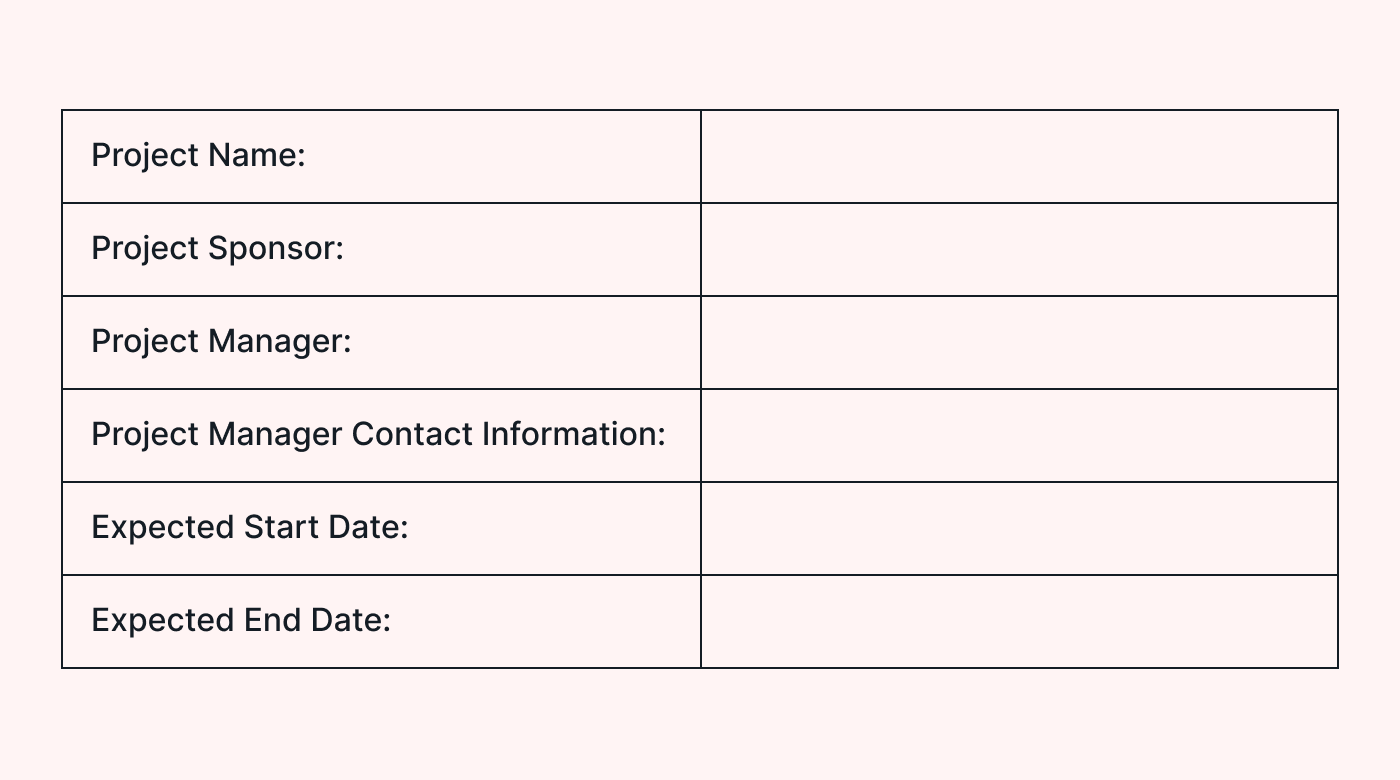 |
Having all this information in a table makes it far easier for sponsors to understand what the project’s about, who’s involved, how to contact them, and your estimated time frame.
2. Create your project objective
Next, you’ll identify the specific objective for the project. This is essentially the top-level reason for running the project in the first place. For example, you might be aiming to remodel your website, launch a new product, or design a new app.
To create effective project goals and objectives, consider using the SMART framework.
SMART is an acronym for specific, measurable, achievable, relevant, and time-bound. The framework helps you create clear and appropriate objectives for your project.
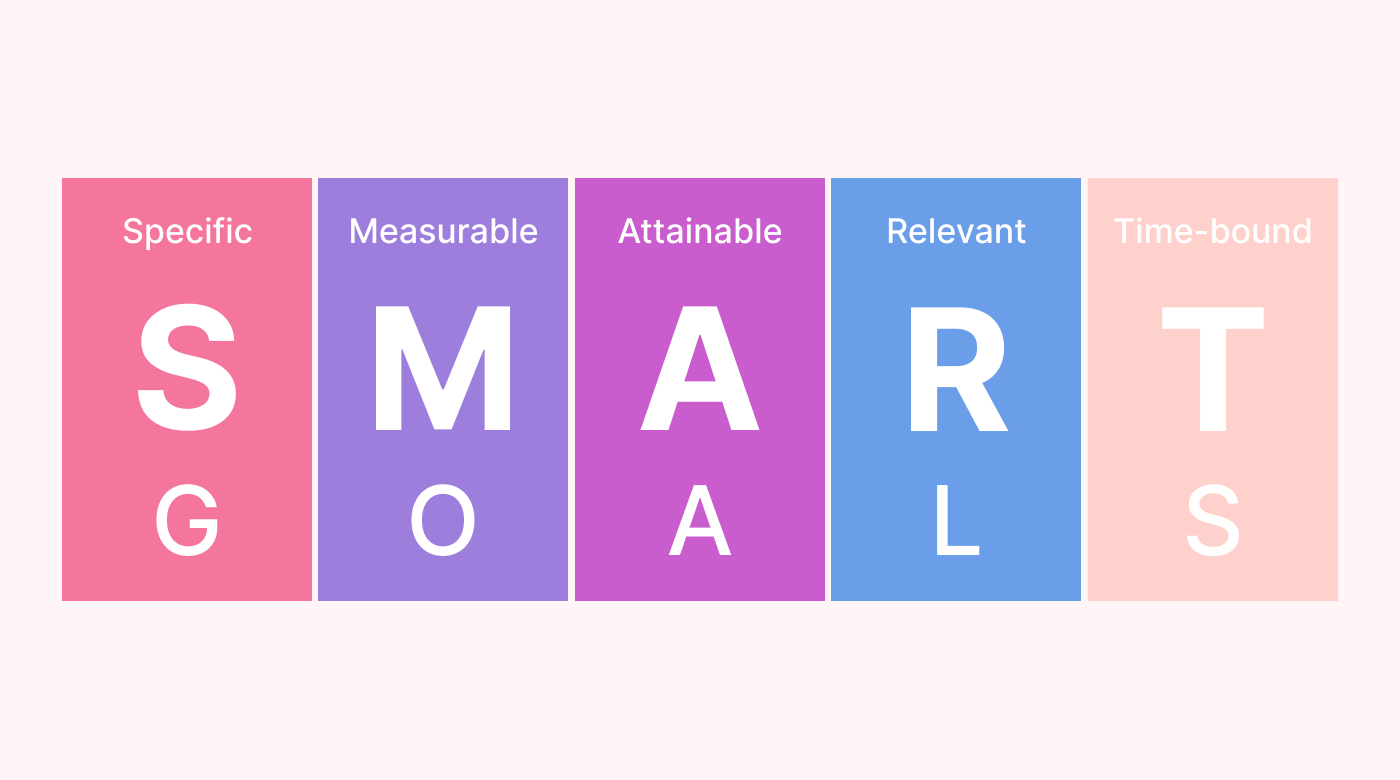 |
Here’s an example of a SMART goal so you can see it in action:
Launch a new mobile app for customers to place online orders within the next 6 months and get 200 downloads by the end of the year to improve the customer experience.
3. Define project scope
The next step is clearly stating what work falls within the project limits (and, by default, what work falls outside the project’s purview). Doing this helps manage stakeholder expectations and makes it easier for the project manager to plan the project after approval.
Defining the scope could be as simple as a short sentence or two that defines exactly what the project will cover.
Take a look at this project scope statement for a web redesign as an example:
The project scope includes designing the website architecture and implementing responsive design. It excludes backend development, content creation/migration, and integration with external systems.
4. Confirm the deliverables
After confirming the scope, you’ll define key deliverables that the project will produce or achieve. These can be tangible outputs and desired outcomes. For example, if you’re launching a new product, a key deliverable will be the design of that product.
You can also plot key milestones as markers of success. For instance, designing 50% of your new product could be a milestone to hit along the way to the final product.
If you decide to include milestones in your charter, consider using Motion to plot those out.
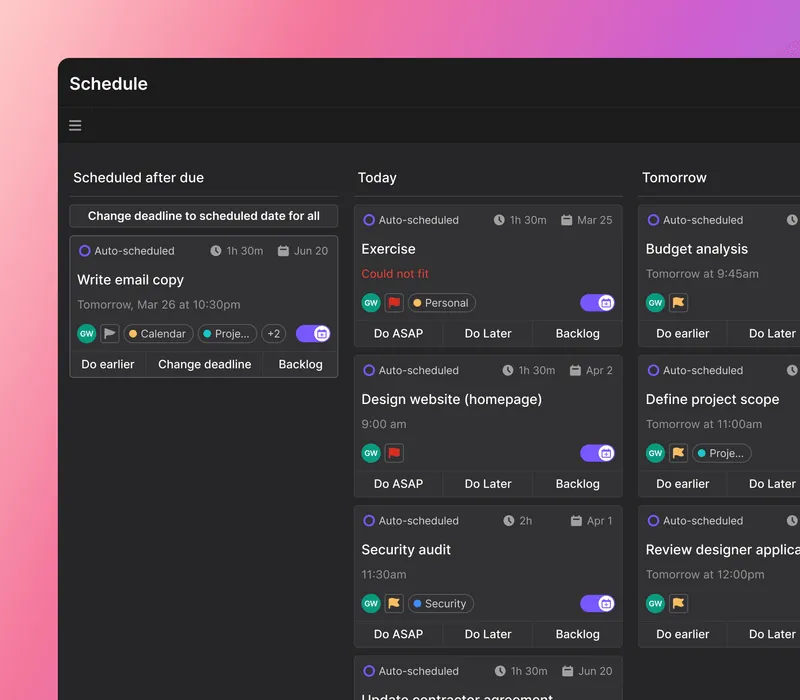 |
Our platform makes it easy for teams to visualize milestones and track progress in real-time.
5. Define roles and responsibilities
Identify key stakeholders who have an interest or influence in the project. This includes project sponsors, the project manager, team members, clients, users, and any other relevant individuals or groups.
When it comes to the project team, you’ll also outline their responsibilities in the project. For instance, the marketing team will be responsible for conducting market research, launching a promotional campaign, and so on.
Additionally, you’ll also need to clarify reporting structures and lines of authority. This will help you make sure that everyone knows their role, and who they report to (for updates and queries).
5. Establish project timeline
Now, you can create a high-level timeline for the project. This will outline the key events that’ll take place throughout the project and how long you expect it to take.
As a part of creating the project timeline, you’ll also pinpoint any dependencies that need to be considered during project execution.
Dependencies are tasks that rely on other tasks to be completed. For example, you can’t send an email campaign until the email has been drafted. In this situation, sending the email campaign depends on when the email is drafted.
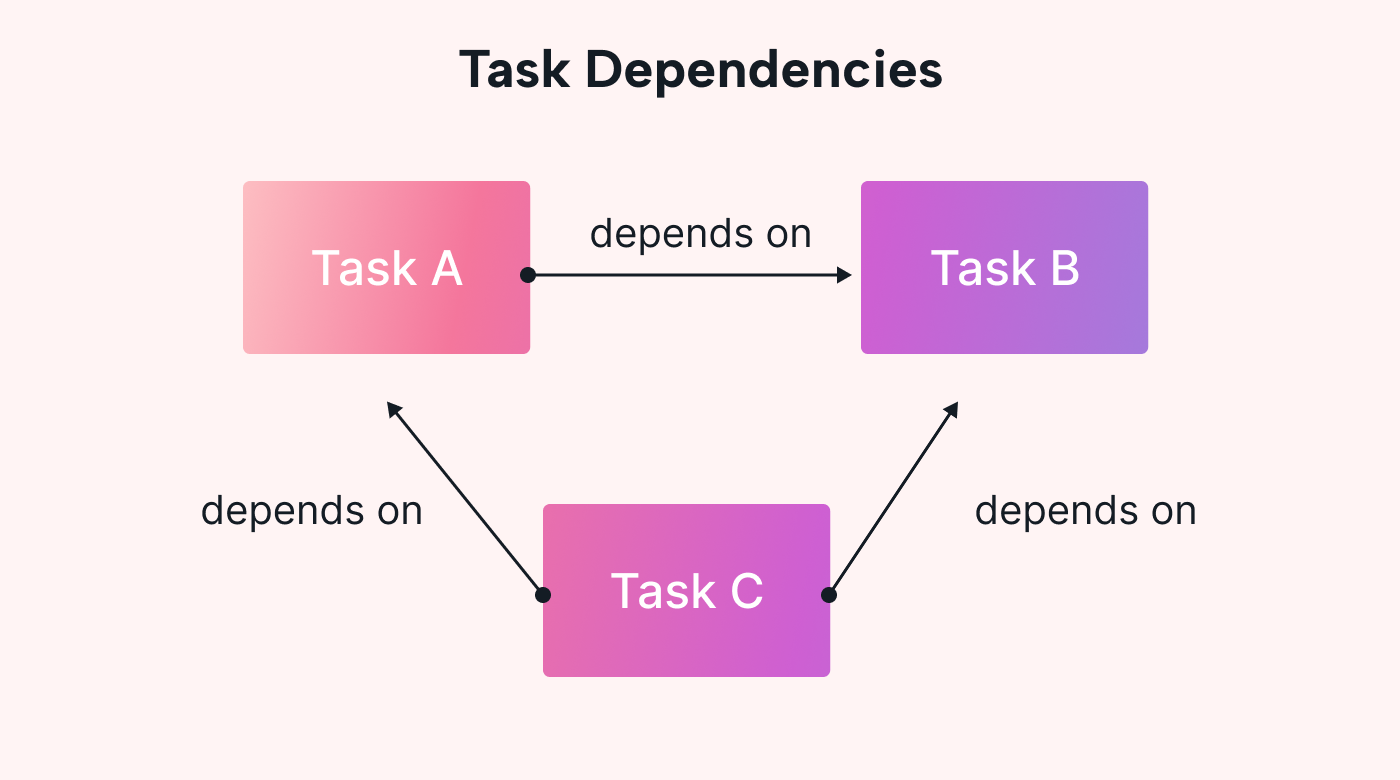 |
Using an online planner like Motion makes this process easier to manage. You can easily see your dependent tasks by making them visible with tags or color-coding.
6. Pinpoint resources
The next step is to estimate the resources required for the project. This includes the following:
- Budget
- Equipment
- Materials
- Capacity
By outlining these resources, you (and the project sponsor) will have a clear idea of what you need to deliver the project successfully.
You should also specify any constraints that may impact the resources in the project.
For example, if unexpected challenges arise, you may need a bigger budget to keep the project on track. It’s important to consider these constraints in advance so you can think about how to address them when the project work starts.
7. Identify potential risks
The penultimate step is to identify potential risks that could impact the project when it goes live. A good way to do this is to complete a risk matrix.
A risk matrix is a visual tool that assesses and prioritizes risks based on the likelihood they’ll happen and their potential impact. Here’s an example of a simple 3x3 risk matrix:
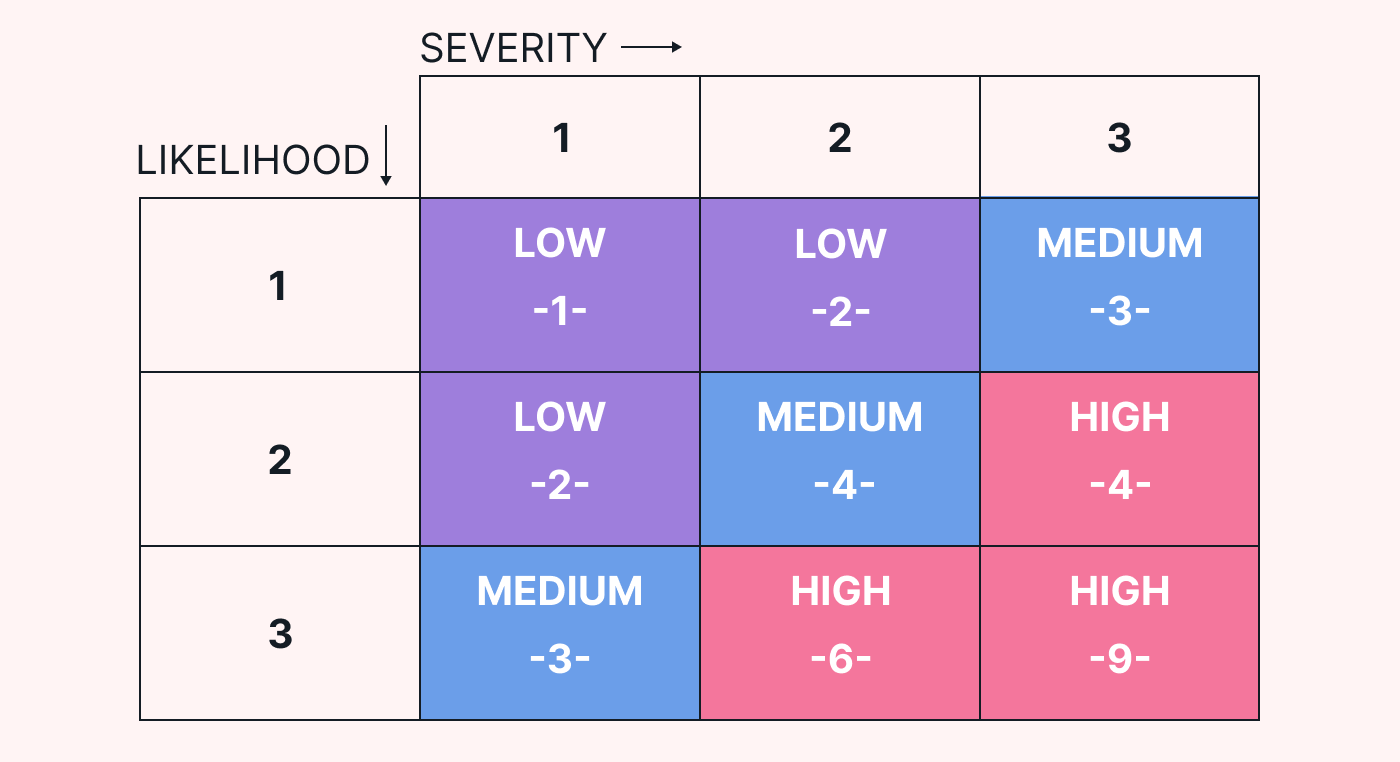 |
With the matrix, you’ll have a clear picture of if and how likely certain risks will happen, and the damage if they do occur. This is useful information to consider when deciding whether to give the green light on the project.
8. Share the charter for approval
The last step is to share the final charter with the relevant stakeholders for approval and feedback. This is the final step before project approval, so make sure that your project charter includes all the relevant information before sharing.
When it comes to sharing the charter, it’s helpful to do so via a collaborative, online platform like Motion.
 |
As a result, everyone can easily access the information, add comments, and respond to queries in a central location.
FAQs about project charters
Let’s answer some of the most commonly-asked questions about project charters.
What is the difference between a project charter and a project scope?
The project scope is part of the overall project charter. It defines the boundaries of the project, the work that needs to be done, and the criteria for project success.
What is the difference between a project charter and a project plan?
The project charter defines the project's purpose and objectives, while the project plan outlines the execution of the project, including detailed tasks, timelines, and resources.
Who defines the project charter?
The project charter is typically defined by the person with the authority to approve the project (usually the project sponsor). They may work in collaboration with the project manager and other key stakeholders to draft and finalize the project charter.
How long should a project charter be?
A typical project charter can range from a few pages to around 10–15 pages, but it ultimately depends on the specific project and the needs of the organization. It should be long enough to provide relevant details but not so long that it’s difficult to read and understand.
How do I get a project charter approved?
The project charter is presented to the appropriate stakeholders for formal approval. This may involve a review meeting, presentation, or submission to a project governance board. You’ll usually get approval (and signatures) when everyone agrees that the project charter is accurate and aligns with organizational goals.
What happens after the project charter is approved?
Once the project charter is approved, it provides the foundation for project planning and execution. It serves as a reference throughout the project's lifecycle to ensure everyone’s on the same page and that the project is successful.
Manage your project charter with Motion
If you’re thinking about writing a project charter, use Motion to plan and manage all the key information with our work management tool.
You can easily collaborate with your project team (and project sponsor), review your resources, and track against the project timeline in a single location.
Sign up for a free trial to get started.





